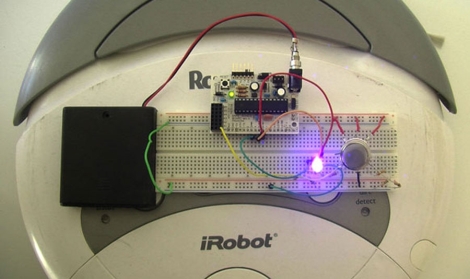
The next time you set off for a long day in the coal mines, forget the canary – bring your Roomba along instead!
While we are pretty sure that canaries are no longer used in the mining industry, this Roomba hack could make a suitable replacement if they were. A team from the Public Laboratory for Open Technology and Science (PLOTS) recently showed off a Roomba which they modified to test an area’s air quality. Using an Arduino and a volatile organic chemical (VOC) detecting air quality sensor, the Roomba goes about its normal business, lighting an LED any time it encounters overly contaminated air. When captured via a long exposure image, the process creates a “bad air” map of sorts, with the polluted areas highlighted by the glow of the LED.
While the Roomba currently only detects VOCs, the team plans on adding additional sensors in the near future to expand its functionality. The Roomba is merely a proof of concept at the moment, but we imagine that similar technology will be adapted for use in unmanned explorations of chemically hostile environments, if that hasn’t happened already.
[via DVice] [Image via TechnologyReview]
















The “bad air” map is an interesting idea, but doesn’t the air move around and change the distribution? Wouldn’t even the Roomba itself passing by blow some of the gases around into a new pattern?
I think I like the idea of driving it around an office and making some kind of a heat-map of the VOCs surrounding a particularly gassy co-worker’s cube, or something.
It’d be extremely useful if there were a mobile way to visually map the presence and concentration of radon (or its’ byproducts)…
Not really a roomba hack though, they just basically duct taped an arduino and a sensor with an LED to the top of the thing.
They plan to draw he map of the Roomba with the results of the sensor, So we can see where is what.
@george:
It would be quite simple to adapt this for use in radon/radioisotope mapping, but a handheld detector with gps would be equally or more useful.
I’ve been wanting to play with my favorite local pollutant, SO2, but those sensors seem a weeeeee bit pricey (~$300).
Luke: I was thinking for use in indoor/underground confined spaces like utility tunnels, etc, where GPS wouldn’t work and people might not want to be using a sampling device at the end of their arm. Cuz, y’know, “Beep, beep, beep. Ohai, you’re kneeling in an area that exceeds the maximum permissible concentrations of $BADTHING, you should probably leave now.”
cmholm: I prefer H2S, but to each their own. :)
haha…. now my roomba can avoid the bathroom after my in-laws visit too AND prove conclusively that the entire area surrounding the bathroom is hazardous.
code? i have been looking for code on how to use those air quality sensors
I don’t know how that sensor outputs it’s readings but surely there’s a way to dim an led with it without a whole microcontroller.
Great.
I like the way to extend the functionnality of the Roomba.
+1.